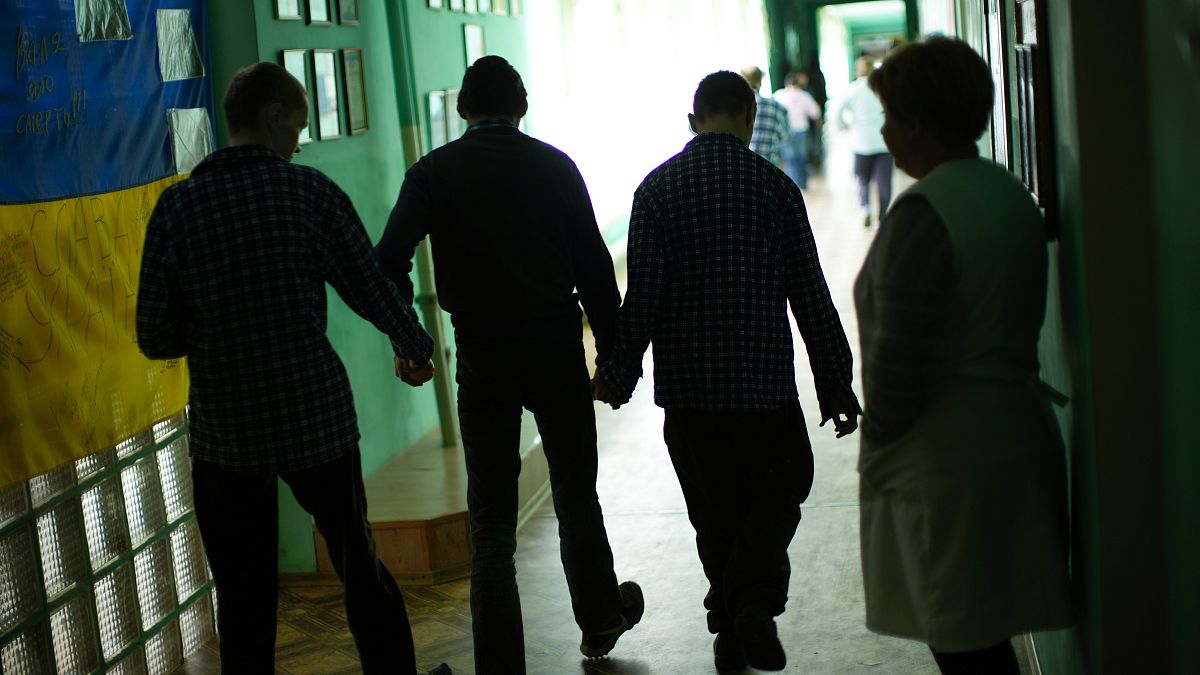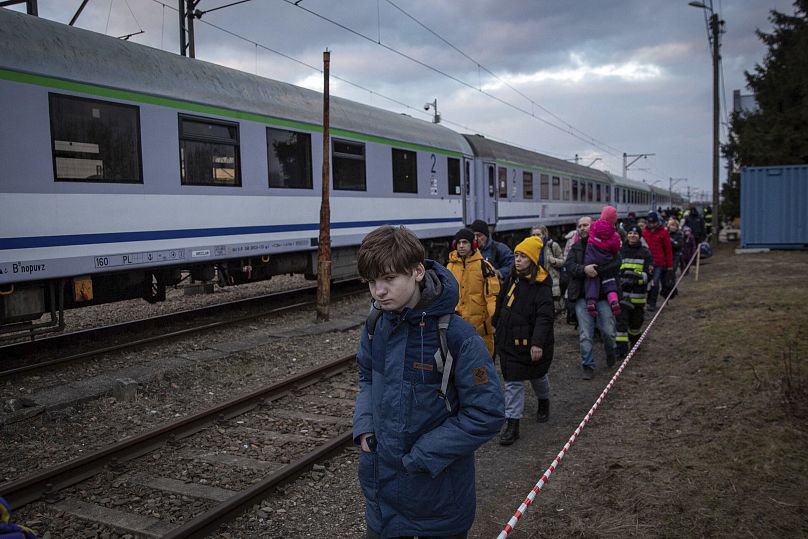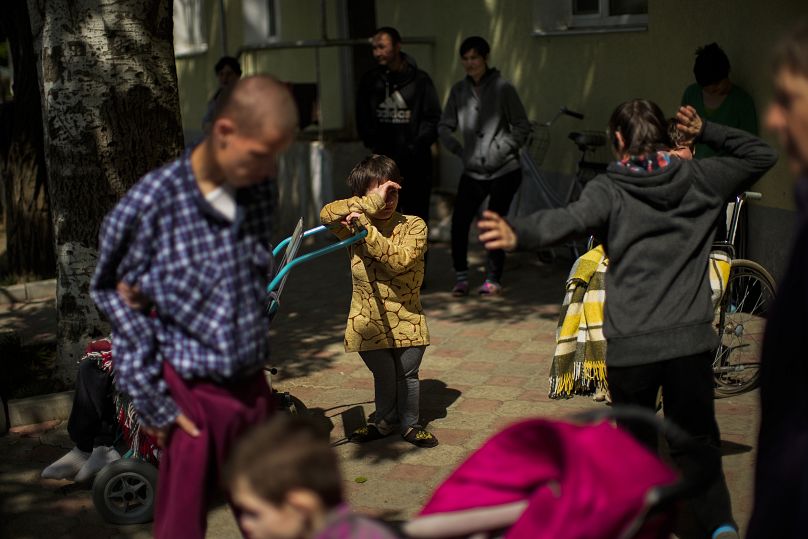People are living in squalid, inhumane conditions, sometimes tied to beds in caretakers’ well-intentioned efforts to restrain them from self-harm. But the underlying issues extend beyond war.
War has torn through institutions caring for disabled people in Ukraine, drastically worsening living conditions and displacing thousands. Investigations detail people living in squalid, inhumane conditions.
Overwhelmed staff have resorted to tying patients to their beds in an effort to restrain them from self-harm, NGOs report.
The war has drastically increased the stress on an already shaky system but the problem runs deeper.
“We believe these places were dangerous, neglectful, and inappropriate before the war… but now you just have more kids, overwhelmed staff, fewer resources, extra trauma from the kids having lost everyone they ever knew, and a real life-threatening situation," Eric Rosenthal, founder and director of Disability Rights International (DRI) said.
‘Overwhelmed staff, fewer resources, extra trauma’
There are at least 100,000 people living in institutions across Ukraine according to Inclusion Europe, a disability services and support organisation. Others argue the number is higher as people fleeing war are also finding shelter in these centres.
The increase in people, combined with a decreased number of staff, can be a lethal combination.
Rosenthal and fellow DRI director Halyna Kurylo went inside Ukraine's institutions following the onset of the war to assess the situation on the ground.
“What we saw was a slow death speeded up... they're dying in large numbers” Rosenthal said.
“You saw one disabled child taking care of another disabled child, you saw self-abuse, biting themselves, hitting themselves, rocking back and forth, clenching their teeth," he added.
"Our nurse at the time observed that these children were malnourished—people will stop eating if they have no reason to live.”
Kurylo also reported seeing children "sometimes tied to beds, or (with) their hands tied".
“It’s not that the staff wants something bad for them, but they end up basically torturing them, because there’s not enough staff to make sure they don’t kill themselves or they don’t die accidentally,” Kurylo explained. “So they do whatever they can to prevent this, in order not to have responsibility later.”
Rosenthal says the situation has worsened since then.
In one centre that Kurylo visited this month, 12 children were sleeping in a single room that had been converted from a barn. In other, larger institutions, staff are struggling to manage upwards of 200 people.
“There are all kinds of things—chemical restraint, physical restraint—overmedicating them,” Kurylo said.
The onset of war
When war erupted on 24 February, directors of the institutions housing Ukraine’s disabled population—who, according to Kurylo, are not required by law to have experience in clinical care—suddenly had to strategise the next move.
“When we were calling them [to help], they said ‘but we have 50, 60, 80% of bedridden children with mobility issues, with a lot of health issues, and they will not survive the road …even if they do survive the road, we don’t have somewhere to take them to, and we don’t have transportation,’” Kurylo recounted.
Plans were made on an institution-by-institution basis, without formal direction from the government.
“My understanding is that it was based on chance… I am not aware that there was any centrally managed process to do this,” Milan Šveřepa, the director of Inclusion Europe, said over the phone.
People with the highest support needs were left behind without enough staff to care for them.
“It was done like a triage… there was no logic,” Kurylo said.
‘The biggest problem is a failure of leadership’
There isn’t a lack of funding going into institutions. But—in what seems counterintuitive—this is part of the problem.
According to international organisations, the best way to address the problems of institutionalisation is to move people out of them.
“The biggest problem is a failure of leadership," Rosenthal said. “Any money that goes to those institutions strengthens an inherently segregated system.”
There is extensive research about the urgent need for deinstitutionalisation. On paper, the world’s biggest organisations and governments are on board. In practice, delivering aid money or fixing the grounds of institutions can seem like an easier and more visible fix than rewiring an entire system.
“While we were visiting [an institution], a Christian agency from Europe came in and said, ‘oh, we're taking a look, we're gonna rebuild the playground,’” Rosenthal recounted. “Well, this is where the kids are lying on the ground eating dirt.”
“You really need to use your brain, and not your protocols as organisations, to do it right,” Kurylo said. “It’s always easier to help an institution because it’s visible, and it’s an easy solution, it seems to donors… you come, you help, you tick the box… it’s much more difficult to work together on a sustainable solution.”
‘If you just give the money to the institution, it will further segregate them’
Most of the disabled people living in institutionalised care have families that could care for them with the right support, according to Kurylo.
“A lot of money has come into institutions, while families of children with disabilities, who are in communities, live on the verge of poverty because of the war,” Kurylo said. “They have no access to services, no access to medication… they are invisible and nobody supports them.”
Redirecting money from institutions into homes could allow for people with disabilities to live in safer environments with individualised care in the long term.
“There has to be attention on supporting families of children with disabilities, together with thinking about how we take our children who are in danger of these institutions out step by step, creating individual plans to have them in the community,” Kurylo said. “Otherwise, we’ll emerge from this war with strengths in the custodial system.”
Plans and detailed recommendations have already been drafted and shared with international organisations and the Ukrainian government.
“Reform only happens when there is pressure to reform,” Rosenthal said. “It's easy to forget children with disabilities… it's cheaper to keep kids with families, but during a transition, it requires an investment of new resources to create new programmes.”
“We have bright minds on the international level,” Kurylo said. “We have to put them together and think of other solutions. No compromises.”


